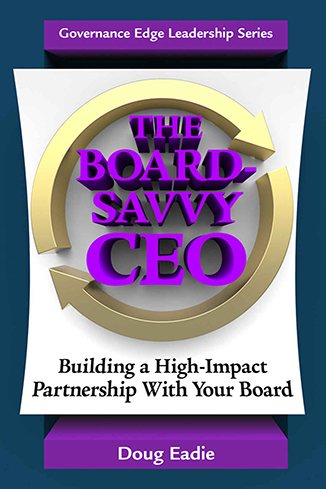 As always, I learned as much as I taught from the economic development chief executives participating in the workshop I presented on February 10 at the Leadership Summit of the International Economic Development Council – “Cementing the Board-CEO Partnership in Your Economic Development Organization.” The diverse, high-level experience participants brought to the session made for a stimulating, thought-provoking 90 minutes. We spent the better part of 45 minutes discussing practical ways to cement the CEOs’ working relationship with their boards. One of the relationship building tools we closely examined was board evaluation of the CEO’s performance, which long experience has taught me is a potentially powerful relationship sealant. But, as we discussed at the Summit workshop, I didn’t mean one of those highly subjective and essentially meaningless questionnaires that board members often individually fill out in the privacy of their own offices.
As always, I learned as much as I taught from the economic development chief executives participating in the workshop I presented on February 10 at the Leadership Summit of the International Economic Development Council – “Cementing the Board-CEO Partnership in Your Economic Development Organization.” The diverse, high-level experience participants brought to the session made for a stimulating, thought-provoking 90 minutes. We spent the better part of 45 minutes discussing practical ways to cement the CEOs’ working relationship with their boards. One of the relationship building tools we closely examined was board evaluation of the CEO’s performance, which long experience has taught me is a potentially powerful relationship sealant. But, as we discussed at the Summit workshop, I didn’t mean one of those highly subjective and essentially meaningless questionnaires that board members often individually fill out in the privacy of their own offices.
These questionnaires miss the point by having board members assess their CEO’s functional excellence rather than measurable bottom-line outcomes. For example, using one of those notorious 0 to 5 scales, board members typically judge how well the CEO has performed in carrying out such functions as hiring and motivating top administrators, strategic planning, financial planning and management, external relations, etc. Although tabulating board members’ numerical rankings to come up with average CEOt scores in each functional area lends an air of scientific precision to the evaluation process, it is basically a highly subjective opinion survey. If it weren’t bad enough that the questionnaire process involves making subjective judgments about irrelevant performance metrics, it is open to abuse, putting the CEO professionally at risk. Believe me, on several occasions over the years I’ve witnessed board members who were “out to get” their CEO assign rankings of 0 or 1 in several functional categories, ensuring that the CEO’s averaged overall score was in the mediocre – or worse – range. The complete absence of objectivity and quality control make the traditional questionnaire a potentially lethal tool indeed!
The remedy we discussed in the Summit workshop? Employing an evaluation process that focuses on pertinent, measurable outcomes, rather than functional excellence, at two levels. The obvious level is districtwide outcomes that are typically identified in the annual operational planning process (e.g., attracting 10 firms to our region; helping a local manufacturing firm raise its export income by 25 percent; completing the first phase of our downtown waterfront development project; and the like). The second, less obvious level involves what I call the CEO’s “CEO-centric” outcomes, which are typically negotiated toward the end of the fiscal year with the board’s governance or board operations committee. These CEO-centric outcomes are essentially targets that the CEO intends to make a top leadership priority of her own – that she will devote significant time and attention of her own to achieving. For example, the CEO of a downtown development corporation reached agreement with his board’s governance committee on such CEO targets as recruiting four new CEOs for the organization’s board, obtaining a county government subsidy to support the corporation, and ensuring that the board’s newly created standing committees are fully functional during the first quarter of the new year.
We had a really robust discussion during the Summit workshop about what makes employing these CEO-centric outcomes in the evaluation process such a potentially powerful board-superintendent relationship sealant. As I shared with workshop participants, the CEO’s discussing his own CEO-centric leadership targets sends a clear signal: “I welcome your input on my leadership goals as your chief executive officer. To make a real difference in our region, we have to work closely together, and I’m not the least bit worried about your treading on what might be seen as my turf.” My readers well know that in the “olden days,” traditional CEOs would have felt the need to maintain distance from their board and protect their CEO turf from board incursions. But I’m seeing a new breed of CEOs these days, who see themselves as hybrid leaders: part board member, part top executive. This new breed will without question be far more effective at building lasting partnerships with their boards and, as a consequence, significantly boost organizational performance.
By the way, you’ll find a detailed discussion of the CEO evaluation process in Chapter Four of my Governance Edge book, “The Board-Savvy CEO.”





